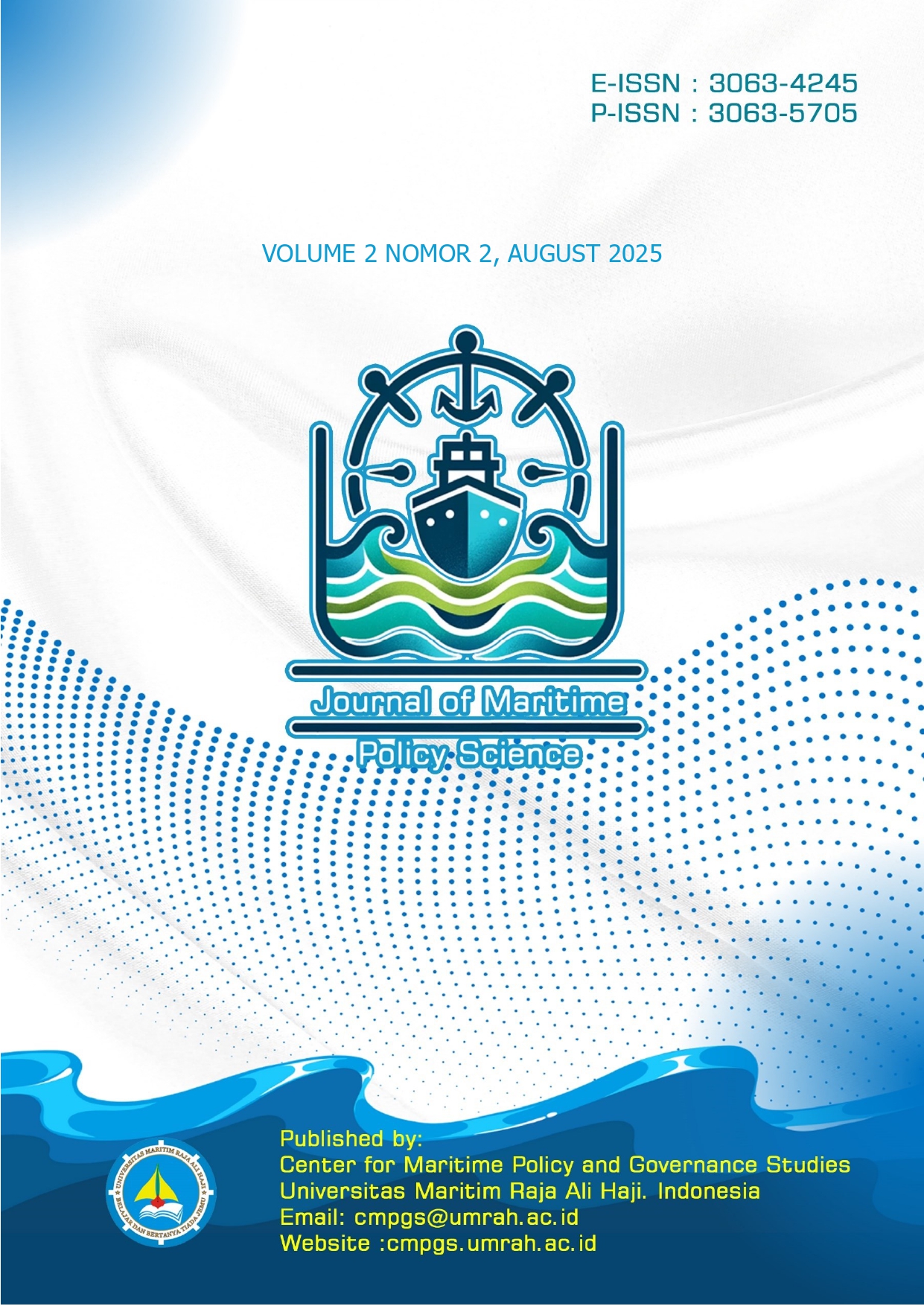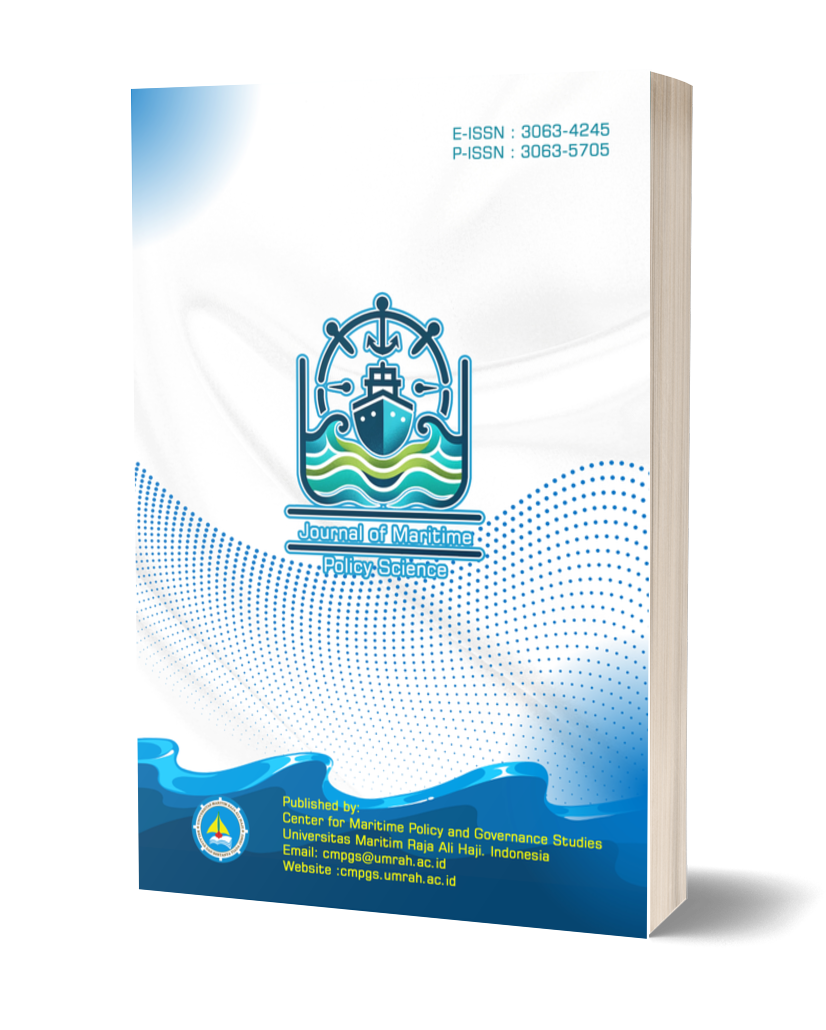Formation of Strategic Provinces on Maritime Borders: A Political Economy Analysis of Natuna-Anambas Proposal
DOI:
https://doi.org/10.31629/jmps.v2i2.7432Keywords:
Fiscal Independence, Decentralization, Political Economy, National StrategicAbstract
The Natuna and Anambas regions have a strategic position as a maritime border region that is a concern in the national agenda, including through designation as part of the National Strategic Project (PSN). However, the reality of local development shows high fiscal dependence on central transfers, weak local revenue, and vulnerability to global economic fluctuations. This study aims to assess the potential of the Natuna-Anambas Province formation in strengthening fiscal independence and improving local economic governance. Using an exploratory qualitative approach and fiscal policy analysis, this study utilizes secondary data from regional financial reports, BPS statistics, and a literature review related to fiscal decentralization and the resource curse. The results show that the regional revenue structure dominated by the General Allocation Fund (DAU) and Revenue Sharing Fund (DBH) makes Natuna and Anambas vulnerable to central policy changes and commodity price volatility. In addition, the benefits of PSN have not been fully distributed to local communities due to limited institutional capacity and lack of integration of local economic development. The establishment of a new province has the potential to be a solution if accompanied by strengthening fiscal governance, reforming DBH allocation, and economic diversification strategies. This article recommends a policy roadmap based on a multi-level governance approach to promote fiscal autonomy and inclusive and sustainable economic development.
Downloads
References
Auty, R. M. (1995). Economic Development and the Resource Curse Thesis.
BPK Perwakilan Provinsi Kepri. (2024, November 15). APBD Anambas 2025 Diprediksi Menurun Jadi Rp895 Miliar, Mayoritas Digunakan Untuk Belanja Pegawai. https://kepri.bpk.go.id/apbd-anambas-2025-diprediksi-menurun-jadi-rp895-miliar-mayoritas-digunakan-untuk-belanja-pegawai/
BPS Kabupaten Kepulauan Anambas. (2025). Kabupaten Kepulauan Anambas Dalam Angka 2025.
BPS Kabupaten Natuna. (2025). Kabupaten Natuna Dalam Angka 2025.
Brenner, N. (2004). New State Spaces: Urban Governance and the Rescaling of Statehood. https://www.researchgate.net/publication/227467930
Digdowiseiso, K. (2023). Institutional Quality As The Driver of Fiscal Decentralization in Developing Countries. Cogent Economics and Finance, 11(2). https://doi.org/10.1080/23322039.2023.2234220
Faidillah. (2025, April 23). DAK Tahun 2025 Dinas PUPR Anambas Dipangkas Nol Rupiah. Antena.Id. https://www.antena.id/2025/04/dak-tahun-2025-dinas-pupr-anambas.html
Fitrani, F., Hofman, B., & Kaiser, K. (2005). Unity in diversity? The creation of new local governments in a decentralising Indonesia. Bulletin of Indonesian Economic Studies, 41(1), 57–79. https://doi.org/10.1080/00074910500072690
Ginanjar, R. A. F., Sutjipto, H., Sugiyarto, Rahmat, B., Hadi, S., & Sardjasasmita, A. (2025). Analysis of the Impact of Fiscal Decentralization on Regional Fiscal Imbalances: A Cross-Region Case Study in Java. Indonesian Treasury Review Jurnal Perbendaharaan Keuangan Negara Dan Kebijakan Publik, 10(1), 39–52. https://doi.org/10.33105/itrev.v10i1.1131
Hamidi, U. S., Puspita, D., Dewi Puspita, », Pahlevi, M., Raharja, M., Hadi, S., Latief Baroto, A., Permana, A. W., & Rahayu, W. T. (2021). Two Decades of Fiscal Decentralization Implementation in Indonesia Editors: United States Agency for International Development Economic Growth Support Activity (USAID EGSA).
Lewis, B. D. (2023). Indonesia’s New Fiscal Decentralisation Law: A Critical Assessment. Bulletin of Indonesian Economic Studies, 59(1), 1–28. https://doi.org/10.1080/00074918.2023.2180838
Li, H., & Seifert, J. (2015). Indonesia’s Fiscal Decentralization and Its Effect on Provincial Public Finances. Public Finance and Management, 15, 108–129.
North, D. C. (1990). Political Economy of Institutions and Decisions.
Oates, W. E., New, Y., & Jovanovich, H. B. (2014). Fiscal Federalism.
Putri, R. N. H., Susilo, & Saputra, P. M. A. (2019). Decentralization and Financial Local Governments Performance: How Does Fiscal Autonomy Affect Spending, Economic Growth, and Poverty in East Java Indonesia? Journal of Poverty, Investment and Development. https://doi.org/10.7176/jpid/51-04
Sachs, J. D., & Warner, A. M. (1995). Natural Resource Abundance and Economic Growth.
Simandjuntak, D. (2017). Developing Poor Little Rich Natuna’s Economy. http://nasional.kompas.com/read/2016/06/28/16134891/pangkalan.militer.di.natuna.dilengkapi.pes
Sofilda, E., Zilal Hamzah, M., & Kusairi, S. (2023). Analysis of fiscal decentralisation, human development, and regional economic growth in indonesia. Cogent Economics and Finance, 11(1). https://doi.org/10.1080/23322039.2023.2220520
Downloads
Published
Issue
Section
License
Copyright (c) 2025 Fery Andana, Kartono Kartono (Author)

This work is licensed under a Creative Commons Attribution-ShareAlike 4.0 International License.
You are free to:
- Share — copy and redistribute the material in any medium or format for any purpose, even commercially.
- Adapt — remix, transform, and build upon the material for any purpose, even commercially.
- The licensor cannot revoke these freedoms as long as you follow the license terms.
Under the following terms:
- Attribution — You must give appropriate credit, provide a link to the license, and indicate if changes were made . You may do so in any reasonable manner, but not in any way that suggests the licensor endorses you or your use.
- ShareAlike — If you remix, transform, or build upon the material, you must distribute your contributions under the same license as the original.
- No additional restrictions — You may not apply legal terms or technological measures that legally restrict others from doing anything the license permits.













